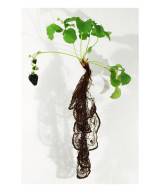To programme architecture
BIO COMPUTATION

DAVID BENJAMIN
In the growing discipline of synthetic biology, living systems are engineered to help solve problems across various industries. For this project, David Benjamin and his firm The Living are designing new composite building materials through a pioneering intersection of synthetic biology, architecture, and computation. These new composite materials offer insight into the near future when synthetic biology may help us design and manufacture the built environment with higher performance and lower environmental impact than traditional methods.
In this project, bacteria become factories for manufacturing building materials through a combination of three of their natural features. Bacteria can produce flexible, fabric-like substance as well as rigid, brick-like substance. Bacteria can also generate complex, self-organised patterns. In an experiment combining these features, two different types of genetically modified bacteria are mixed in a large petri dish with nutrients, and through their growth and interaction they generate flat sheets of material with distinct rigid and flexible regions.

Bacteria become factories for manufacturing building materials through a combination of three of their natural features.
This process, which is still being refined in the lab, is then modelled in a software workflow. Thousands of design options are explored by varying the properties of the bacteria, which translates into different patterns in the sheets. The software workflow is built through Autodesk Maya and custom plug-ins, and it uses techniques of simulation and optimisation common in aerospace and architectural design.
The resulting composite sheets have novel properties of structure and transparency, and they can be applied to new high-performance envelopes in buildings, boats and aeroplanes. In the experiment documented in this exhibit, new composite sheets are designed for potential use in an aeroplane envelope. In the future, these processes of bio-computation and bio-fabrication will offer many more possibilities for design.


